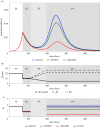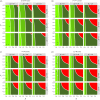Segmentation and shielding of the most vulnerable members of the population as elements of an exit strategy from COVID-19 lockdown
- PMID: 34053266
- PMCID: PMC8165590
- DOI: 10.1098/rstb.2020.0275
Segmentation and shielding of the most vulnerable members of the population as elements of an exit strategy from COVID-19 lockdown
Abstract
This study demonstrates that an adoption of a segmenting and shielding strategy could increase the scope to partially exit COVID-19 lockdown while limiting the risk of an overwhelming second wave of infection. We illustrate this using a mathematical model that segments the vulnerable population and their closest contacts, the 'shielders'. Effects of extending the duration of lockdown and faster or slower transition to post-lockdown conditions and, most importantly, the trade-off between increased protection of the vulnerable segment and fewer restrictions on the general population are explored. Our study shows that the most important determinants of outcome are: (i) post-lockdown transmission rates within the general and between the general and vulnerable segments; (ii) fractions of the population in the vulnerable and shielder segments; (iii) adherence to protective measures; and (iv) build-up of population immunity. Additionally, we found that effective measures in the shielder segment, e.g. intensive routine screening, allow further relaxations in the general population. We find that the outcome of any future policy is strongly influenced by the contact matrix between segments and the relationships between physical distancing measures and transmission rates. This strategy has potential applications for any infectious disease for which there are defined proportions of the population who cannot be treated or who are at risk of severe outcomes. This article is part of the theme issue 'Modelling that shaped the early COVID-19 pandemic response in the UK'.
Keywords: COVID-19; SARS-CoV-2; exit strategy; mathematical model; segmenting and shielding.
Figures






References
-
- World Health Organisation. 2020. Coronavirus disease 2019 (COVID-19) situation report – 51. Geneva, Switzerland: WHO.
-
- World Health Organisation. 2020. Coronavirus disease (COVID-2019) situation reports. See https://www.who.int/emergencies/diseases/novel-coronavirus-2019/situatio... (accessed: 26 April 2020).
-
- Organisation for Economic Co-operation and Development. 2020. OECD policy responses to coronavirus (COVID-19): evaluating the initial impact of COVID-19 containment measures on economic activity. See https://www.oecd.org/coronavirus/policy-responses/evaluating-the-initial... (accessed: 26 April 2020).
-
- British Lung Foundation. 2020. Coronavirus and COVID-19: what is social shielding and who needs to do this? See https://www.blf.org.uk/support-for-you/coronavirus/what-is-social-shielding (accessed: 26 April 2020).
Publication types
MeSH terms
Grants and funding
LinkOut - more resources
Full Text Sources
Other Literature Sources
Medical
Miscellaneous
